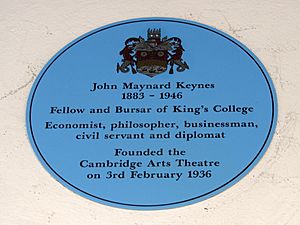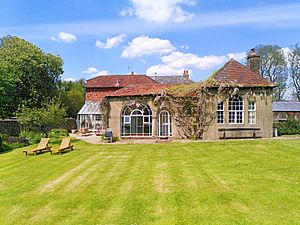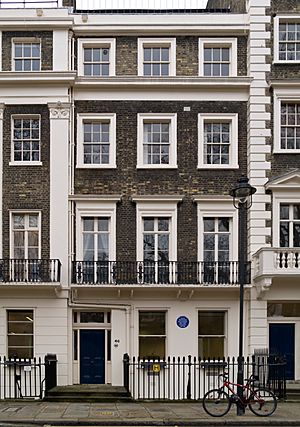John Maynard Keynes facts for kids
Quick facts for kids
John Maynard Keynes
|
|
|---|---|
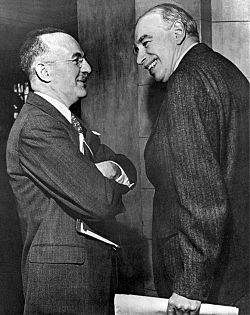
John Maynard Keynes (right) and Harry Dexter White at the Bretton Woods Conference
|
|
| Born | June 5, 1883 |
| Died | April 21, 1946 (aged 62) Tilton, Sussex, UK
|
| Education | Eton College and King's College, Cambridge |
| Occupation | Economist |
| Spouse(s) | Lydia Lopokova |
| Parent(s) | John Neville Keynes, Florence Ada Brown |
| Signature | |
John Maynard Keynes (born June 5, 1883 – died April 21, 1946) was a famous British economist. His ideas, known as Keynesian economics, greatly changed how people thought about economics and government. He believed that governments should use taxes and banking rules to help control economic ups and downs, like recessions (when the economy slows down) and booms (when it grows very fast). He is seen as one of the main founders of modern macroeconomics, which studies how the economy works as a whole.
The Economist magazine called Keynes "Britain's most famous 20th-century economist." Besides being an economist, he also worked for the government, was a director at the Bank of England, and was part of the Bloomsbury Group, a group of writers and thinkers.
Contents
Discovering Keynes's Early Life
John Maynard Keynes was born in Cambridge, England. His father, John Neville Keynes, taught economics at Cambridge University. His mother, Florence Ada Brown, was a successful writer and worked to improve society. His younger brother, Geoffrey Keynes, became a surgeon and loved collecting books. His younger sister, Margaret, married a Nobel Prize winner named Archibald Hill.
Keynes started studying at King’s College, Cambridge in 1902. He first focused on mathematics. Later, he studied economics with famous professors like Alfred Marshall. Many believe Professor Marshall encouraged Keynes to switch from math to economics. Keynes earned his first degree in 1905 and his master's degree in 1908.
Keynes was also a very good investor. He made a lot of money, though he almost lost it all during the Stock Market Crash of 1929. He managed to rebuild his wealth. He also enjoyed collecting rare books, including many papers by Isaac Newton.
Lord Bertrand Russell, a famous philosopher, said Keynes was the smartest person he had ever met. Russell joked that arguing with Keynes made him feel foolish.
Keynes's Important Career
Keynes became a lecturer in economics at Cambridge, with Alfred Marshall even helping to pay his salary. Soon after, he joined a Royal Commission that dealt with Indian money. This allowed him to use his economic ideas in real-world situations.
During World War I, he worked for the British government, advising on money and economic issues.
Keynes also attended the conference that created the Versailles Treaty to end World War I. He wrote two important books, The Economic Consequences of the Peace (1919) and A Revision of the Treaty (1922). In these books, he warned that the huge payments, called reparations, that Germany had to make would harm Germany's economy. He predicted this would lead to more conflict in Europe. His predictions came true when Germany faced very high hyperinflation in 1923.
Keynes's most famous book was General Theory of Employment, Interest and Money, published in 1936. The ideas in this book were very different from older economic theories.
Many historians agree that Keynes influenced U.S. president Roosevelt's New Deal programs. These programs involved the government spending more money than it collected in taxes, known as deficit spending. This idea was used in the New Deal starting in 1938. Over time, Keynes's ideas became widely accepted by economists.
In 1942, Keynes was given the title of Baron Keynes and became a member of the House of Lords. He was a member of the Liberal political party.
During World War II, Keynes wrote How to Pay for the War. He suggested that the war should be paid for by higher taxes. He wanted to avoid inflation, which is when prices rise too quickly.
The End of Keynes's Life
Keynes worked very hard throughout his life, even when he was not well. He helped set up the Bretton Woods system, which created a new way for countries to manage their money globally. He wanted this system to help the world economy.
In 1946, Keynes had several heart attacks. He died on April 21, 1946, at his home in Tilton, England, at age 62. His parents actually lived longer than he did. His brother, Sir Geoffrey Keynes, was a well-known surgeon and scholar.
Keynes's Personal Life
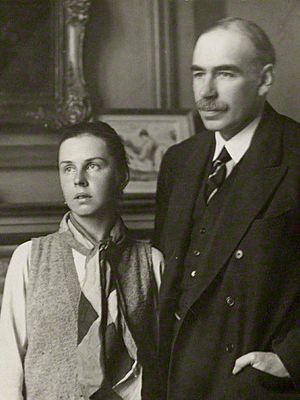
In 1925, Keynes married Lydia Lopokova, a famous Russian ballerina. They hoped to have children, but it did not happen.
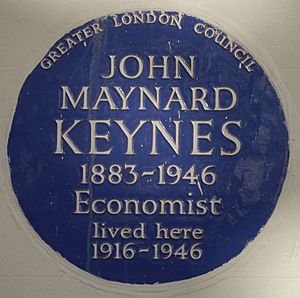
After his marriage, Keynes spent a lot of time at Tilton House, a farm in the countryside. This became their main home when they were not in London.
Supporting the Arts
Keynes believed that working should provide time for fun and relaxation, not just for making money. He wanted people to have shorter working hours and longer holidays.
Keynes loved literature and theater. He helped the Cambridge Arts Theatre financially, making it an important theater outside London.
He also supported the Royal Opera House and the Ballet Company at Sadler's Wells. During World War II, he helped get government money to keep these groups going when their venues were closed. After the war, Keynes helped create the Arts Council of Great Britain and was its first chairman in 1946. The Royal Opera House and Sadler's Wells received the largest grants from this new organization.
Keynes also collected many beautiful artworks by artists like Paul Cézanne and Pablo Picasso. Some of these artworks are now in the Fitzwilliam Museum. He also collected many of Isaac Newton's papers.
Keynes's Impact and Legacy
From the 1930s to the 1970s, Keynes's ideas were a major influence on economic leaders in Europe, America, and other parts of the world. While economists started to accept his ideas in the late 1930s, it was during World War II that governments really started spending money on a large scale. This spending helped to end unemployment. Economist John Kenneth Galbraith said that the economic recovery after the war showed how well Keynes's ideas worked.
Keynesian ideas became very popular after the war. Some scholars even say that Keynes represents modern liberalism, just as Adam Smith represented older ideas of liberalism. After the war, Winston Churchill tried to stop Keynesian policies, but Clement Attlee's government, which won the 1945 election, continued to follow Keynes's ideas.
Publications
Books by Keynes
- 1913 Indian Currency and Finance
- 1919 The Economic Consequences of the Peace
- 1921 A Treatise on Probability
- 1922 Revision of the Treaty
- 1923 A Tract on Monetary Reform
- 1926 The End of Laissez-Faire
- 1930 A Treatise on Money
- 1931 Essays in Persuasion
- 1933 Essays in Biography
- 1936 The General Theory of Employment, Interest and Money
- 1940 How to Pay for the War: A radical plan for the Chancellor of the Exchequer
- 1949 Two Memoirs
Images for kids
-
King's College, Cambridge. Keynes's grandmother wrote to him saying that, since he was born in Cambridge, people will expect him to be clever.
-
Keynes's colleague, David Lloyd George.
-
The Great Depression and its periods of worldwide economic hardship formed the backdrop against which the Keynesian Revolution took place. This image is Migrant Mother, taken by photographer Dorothea Lange in March 1936.
-
Keynes (right) and the US representative Harry Dexter White at the inaugural meeting of the International Monetary Fund's Board of Governors in Savannah, Georgia in 1946
-
Prime Minister Clement Attlee with King George VI after Attlee won the 1945 election
-
The economist Manmohan Singh, the then prime minister of India, spoke strongly in favour of Keynesian fiscal stimulus at the 2008 G-20 Washington summit.
-
Friedrich Hayek, one of Keynes's most prominent critics
See also
 In Spanish: John Maynard Keynes para niños
In Spanish: John Maynard Keynes para niños


